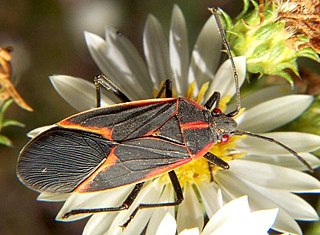Related Research Articles

The boxelder bug is a North American species of true bug. It is found primarily on boxelder trees, as well as maple and ash trees. The adults are about 12.5 millimetres (0.49 in) long with a dark brown or black colouration, relieved by red wing veins and markings on the abdomen; nymphs are bright red.

Ameerega trivittata, formerly Epipedobates trivittatus, is a species of frog in the family Dendrobatidae commonly known as the three-striped poison frog. It is found in Bolivia, Brazil, Colombia, Guyana, Peru, Suriname, Venezuela, possibly Ecuador, and possibly French Guiana.

The Burmese roofed turtle is one of six species of turtle in the genus Batagur of the family Geoemydidae. It is endemic to Myanmar, but was believed to be extinct until rediscovered in 2002. It remains very rare in the wild, but a conservation project has been successful and several hundred are now kept in the Yadanabon Zoological Gardens in Mandalay and a turtle conservation center in Lawkananda Park, Bagan.

Tritia trivittata, common name the threeline mud snail, is a species of sea snail, a marine gastropod mollusk in the family Nassariidae, the Nassa mud snails or dog whelks.
Ilyanassa is a genus of sea snails, marine gastropod mollusks in the family Nassariidae, the Nassa mud snails or dog whelks.

Batagur is a genus of large turtles from South and Southeast Asia. All members of the genus are seriously threatened. With a recent merger with members from two other genera, this genus has six described species.

Gnathocera trivittata is a species of beetles belonging to the family Scarabaeidae.
Aphra trivittata is a moth of the subfamily Arctiinae. It was described by Francis Walker in 1854. It found in Brazil.
Eunidiini is a tribe of longhorn beetles of the subfamily Lamiinae. It was described by Téocchi et al. in 2010.
Eunidia is a genus of longhorn beetles of the subfamily Lamiinae.
Eunidia fallaciosa is a species of beetle in the family Cerambycidae. It was described by Stephan von Breuning in 1939. It is known from Somalia.
Eunidia brunneopunctata is a species of beetle in the family Cerambycidae. It was described by Per Olof Christopher Aurivillius in 1911. It is known from South Africa, Malawi, Angola, Kenya, Ethiopia, Mozambique, Botswana, Sudan, Namibia, Senegal, the Democratic Republic of the Congo, Tanzania, Somalia, and Uganda.
Eunidia kristenseni is a species of beetle in the family Cerambycidae. It was described by Per Olof Christopher Aurivillius in 1911. It is known from tropical Africa.
Eunidia batesi is a species of beetle in the family Cerambycidae. It was described by Olliff in 1889.
Stenostola trivittata is a species of beetle in the family Cerambycidae. It was described by Stephan von Breuning in 1947. It is known from Japan. It contains the varietas Stenostola trivittata var. brunnescens.

Taeniaptera trivittata is a species of stilt-legged flies in the family Micropezidae.

Tipula trivittata is a species of large crane fly in the family Tipulidae.

Lema trivittata, known generally as the three-lined lema beetle or three-lined potato beetle, is a species of leaf beetle in the family Chrysomelidae. It is found in Central America and North America.
Cesonia trivittata is a species of ground spider in the family Gnaphosidae. It is found in the United States and Mexico.
Agroeca trivittata is a species of liocranid sac spider in the family Liocranidae. It is found in the United States.
References
- ↑ BioLib.cz - Eunidia trivittata. Retrieved on 8 September 2014.
| This Eunidiini article is a stub. You can help Wikipedia by expanding it. |